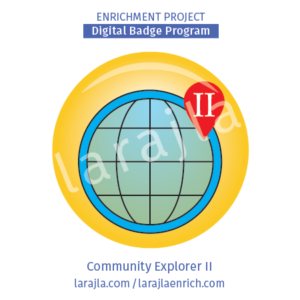 Exploring specific areas within your community can make your own world a lot richer. You need to be part of your community to enjoy it, not just sit and watch from the sidelines.
Exploring specific areas within your community can make your own world a lot richer. You need to be part of your community to enjoy it, not just sit and watch from the sidelines.
In 2017, this badge was broken into two parts. Part 1 highlights the general information you can find. Part 2 goes in-depth on specific places that you might find in your community.
Note: Before you start, plan to keep track of what you learn so you can use this information later.
Steps
1. Waterways and geography.
Do you have waterways? This might include lakes, ponds, rivers and creeks. Perhaps instead you live near mountains or swampland. Is there anything special about them? Are there activities you can do that utilize unique features in your community?
For example, the start of the Little Calumet is nearby and we’ve done an event with the Department of Natural Resources to count and check the size of tadpoles, crayfish, etc. in the area as part of their ongoing record of life and chemicals at the start of the river.
2. Parks.
Find out about the parks in your area. Parks may be local, state or national. What activities do they offer the public for free? Do they have any special programs you can request? How can they add to your exploration of your community?
3. Playgrounds.
This is probably where your kids want to explore. This includes schools, parks and anywhere they can run and play. Most do not have specific activities, but may have an occasional event. What can you do with the kids to help them explore their playgrounds? Would a service project be a good way to improve your community
4. Historical markers.
Many areas have markers where historical events have taken place. Check Wikipedia to start your search. Find out the story behind the marker so you can share it.
5. Historical buildings and museums.
Find information on the oldest buildings in your town. You might also want to include those with unique features or designed by famous architects. Do you have any museums that you can visit with additional local information? Some sites may allow tours so you can learn about them. If so, check them out and learn more.
6. Transportation.
Does your town have transportation that others might think is unusual? How does everyone get around town? Have you tried the various types of transportation available? If your community adapted to a current transportation mode, find out how.
7. Shops and restaurants.
Of course, shopping is very important in many areas. Do you have a lot of smaller shops, strip malls, etc.? Are restaurants locally owned or part of a national chain? Try to find the oldest shops and explore how they have changed. Are there things older stores offer that new ones do not? Ask the same questions for restaurants.
8. Businesses.
Explore the businesses in your area. Why did they choose to locate in your town? What businesses have been around the longest? Which ones have gone out of business or moved? What have they done to change your community?
9. Organizations.
What organizations are represented in your area? These can be for-profit or non-profit. What kind of experiences can they offer non-members? Do you have any organizations that are specific to your community?
10. Share.
Take the information you have gathered, organize it so others can use it and share. This might be through a printed document, blog or Pinterest board of your area.
You can visit my Pinterest board listed below for an idea on sharing.
Supplements
SUPP_Community Explorer II_2in_12up_larajla
- Avery 2” round label printable, 12 up
SUPP_Community Explorer II_Checklist_larajla
- Badge checklist
Sites to Explore
- www.google.com/earth
- www.youtube.com (type in your city / town)
- www.hmdb.org
- en.wikipedia.org/wiki/Historical_marker
Get the infographic here > larajla blog post
Get the PDFs of the badge program / supplements here > Full badge PDFs